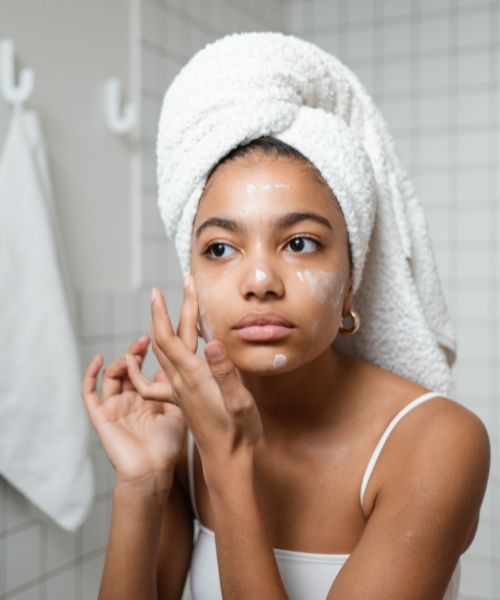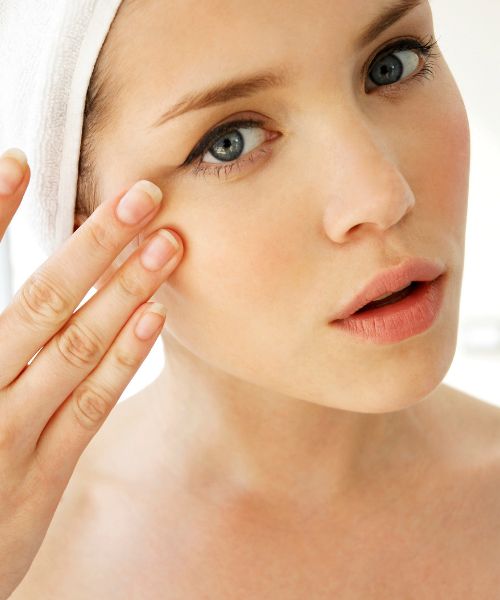Niacinamide and hyaluronic acid are two of the most popular ingredients in modern skincare products, hailed for the many benefits they offer for the skin.
In combination, these two powerhouses can boost hydration levels, reduce inflammation, and strengthen the skin barrier, among other things.
However, it’s important to know how to layer the two ingredients correctly to get the best results.
And while there are many ways to combine them, it’s always best to apply your niacinamide product first and follow it up with hyaluronic acid.
But despite this seemingly foolproof way of using the two ingredients, there are still some key points to keep in mind.
Therefore, in this article, we’ll go over how to layer niacinamide and hyaluronic acid for maximum effectiveness and no adverse effects.

What is Niacinamide and How Does it Work?
Niacinamide is one of the two active forms of vitamin B3 known for its antioxidant, soothing, and barrier-strengthening properties.
Belonging to a water-soluble group of vitamins, niacinamide has become a popular ingredient in beauty and skincare products, as it is known to be effective in addressing several skin concerns as well as offer multiple benefits for the skin.
By enhancing the skin’s protective barrier and reducing moisture loss, niacinamide helps the skin retain hydration. This can help improve the barrier’s function and address skin concerns like visible signs of aging, redness, dullness, and blotchiness.
It has also been observed to balance out the skin’s natural oil production, thus minimizing the appearance of large pores and blemishes.
Finally, niacinamide is also a cell-communicating ingredient that binds to melanocytes, which are pigment-producing cells, to moderate the production of melanin and reduce dark spots, hyperpigmentation, and uneven skin tone.
What is Hyaluronic Acid, and How Does it Work?
Hyaluronic acid is a naturally occurring substance in our body that helps retain moisture, plumpness, and elasticity in the skin.
It binds to water molecules and works as a humectant to draw moisture from the environment and pull it into the skin.
Doing this helps keep the outermost layer of the skin, where dead skin cells don’t have much water content, plump and hydrated.
This ingredient is particularly beneficial for those with dry skin, as hyaluronic acid helps replenish lost hydration while preventing transepidermal water loss.
Its moisture-binding action helps smooth out fine lines and wrinkles caused by dehydration but also makes the skin appear plumper, glowier, and younger.
Hyaluronic acid can also be beneficial for those with oily skin too, and by keeping the skin hydrated, it can help improve its barrier function and reduce the production of excess sebum for a healthier-looking complexion.
How to Layer Niacinamide and Hyaluronic Acid?

The best way to layer niacinamide and hyaluronic acid is to apply niacinamide first and follow it up with hyaluronic acid before it fully dries out.
Then you want to apply your remaining skincare products—moisturizers, sunscreens, oils, and so on—to lock in all the hydration these two ingredients provide.
This method helps them work to their fullest potential, as each ingredient complements the other in providing maximum hydration and protection for the skin.
Another great way to get the benefits of these two ingredients is to use products that contain them both.
This way, you will get all the benefits of niacinamide and hyaluronic acid in one product, allowing your skin to reap the maximum hydration and protection they provide.
It’s important to note that this method of using both ingredients won’t be as potent as when applying two different products, but it’s also less irritating and has less potential to cause adverse effects like sensitive reactions, peeling, redness, etc.
When you’re using two products with higher concentrations of these ingredients, you are exposing your skin to potent quantities of the active ingredients plus the multiple other ingredients present in the product, including stabilizers, emulsifiers, preservatives, etc., which can also potentially trigger some skin reactions.
On the other hand, using a product containing both ingredients in less potent concentrations will still give you the benefits without the risk of sensitivities or adverse effects.
Besides that, niacinamide and hyaluronic acid are both effective at smaller concentrations, so it’s best to start with a product containing their lower concentrations and adjust from there if needed.
In any case, both niacinamide and hyaluronic acid can be used once or twice a day, depending on your concerns and other products in your routine.
The Benefits of Using Niacinamide and Hyaluronic Acid Together
When used together, niacinamide and hyaluronic acid can provide a wealth of benefits for your skin.
Niacinamide’s anti-inflammatory and antioxidant properties help reduce breakouts, redness, and signs of environmental damage like dark spots and hyperpigmentation.
Hyaluronic acid helps attract and retain moisture in the skin, improving its elasticity and keeping it hydrated for longer.
Using them together helps create a barrier that locks moisture in while protecting the skin against damage.
Combining these ingredients can also help reduce signs of aging, like fine lines and wrinkles, as they work together to minimize the damage causing these issues in the first place.
Finally, using niacinamide and hyaluronic acid together can help lighten dark spots by inhibiting melanin production and preventing future hyperpigmentation from forming.
Overall, these two ingredients work well together to provide hydration, protection, and anti-aging benefits, leaving your skin looking brighter, smoother, and younger.
The Risks of Using Niacinamide and Hyaluronic Acid Together

Like all ingredients in skincare products, both niacinamide and hyaluronic acid can trigger some adverse reactions in some instances.
For example, using niacinamide and hyaluronic acid too often, in too strong concentrations, or just bad products can cause irritation, redness, and dryness.
Using products with higher concentrations of these ingredients can also lead to sensitivities, especially if you have reactive skin or your skin barrier is compromised.
Additionally, niacinamide can cause uneven skin texture, while hyaluronic acid can lead to dryness if overused or misused.
Therefore, it’s always important to choose good products, use them correctly, follow them up with other products that work well together, and, most importantly, listen to your skin to know if you need to reduce the frequency of use or switch products altogether.
If your skin is already reactive, sensitive, or compromised, it’s best to go for products with low concentrations of both niacinamide and hyaluronic acid or to opt for products that combine the two ingredients in one.
Additionally, if your skin starts reacting after introducing niacinamide and hyaluronic acid into your routine, it’s best to remove them from your regimen and give your skin a few days to recover.
You can then gradually reintroduce the products one by one and assess how your skin reacts.
This will help you identify which products and concentrations work best for your skin type and condition and which ones are causing the reactions.

My name is Simone and I am a certified skin specialist. I created this website to teach my readers how to take great care of their skin and I also like to occasionally share my honest opinions on skincare products I’ve tried. You can learn more about me here.
